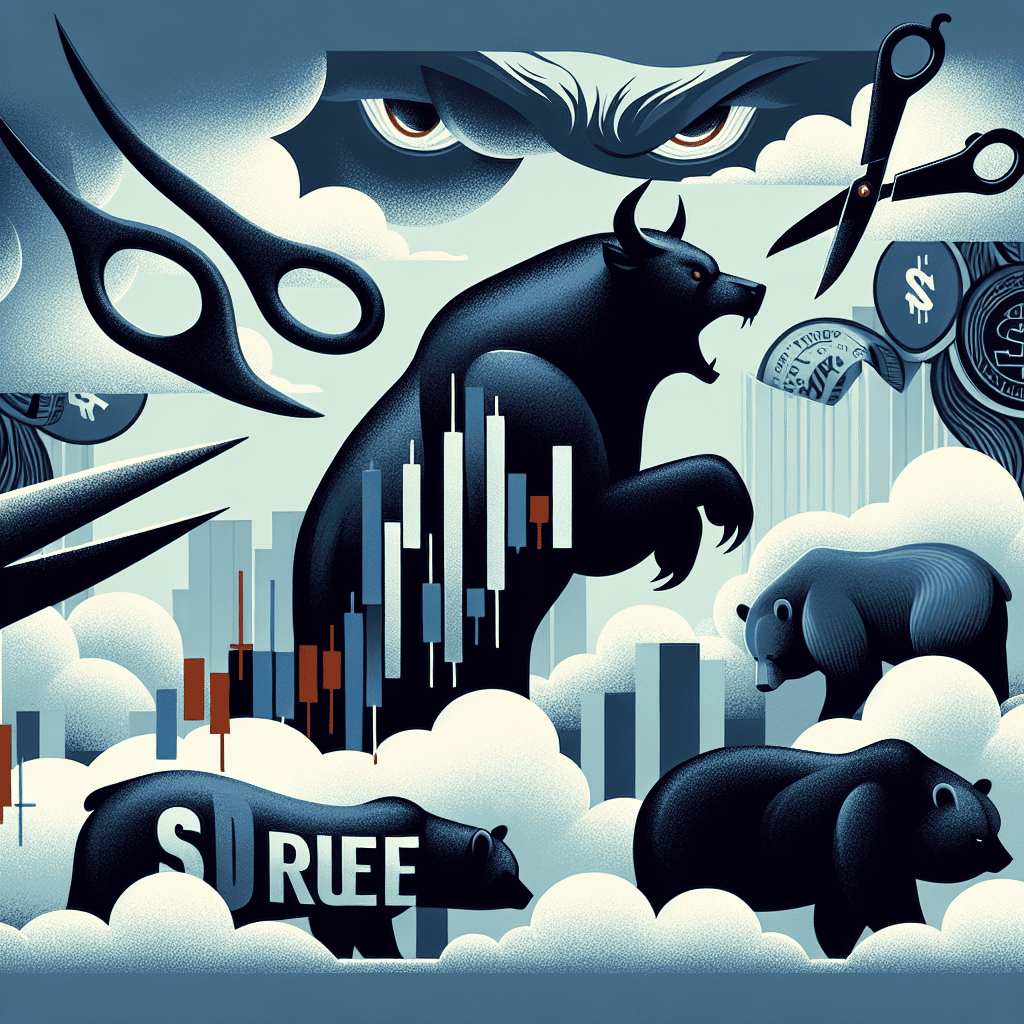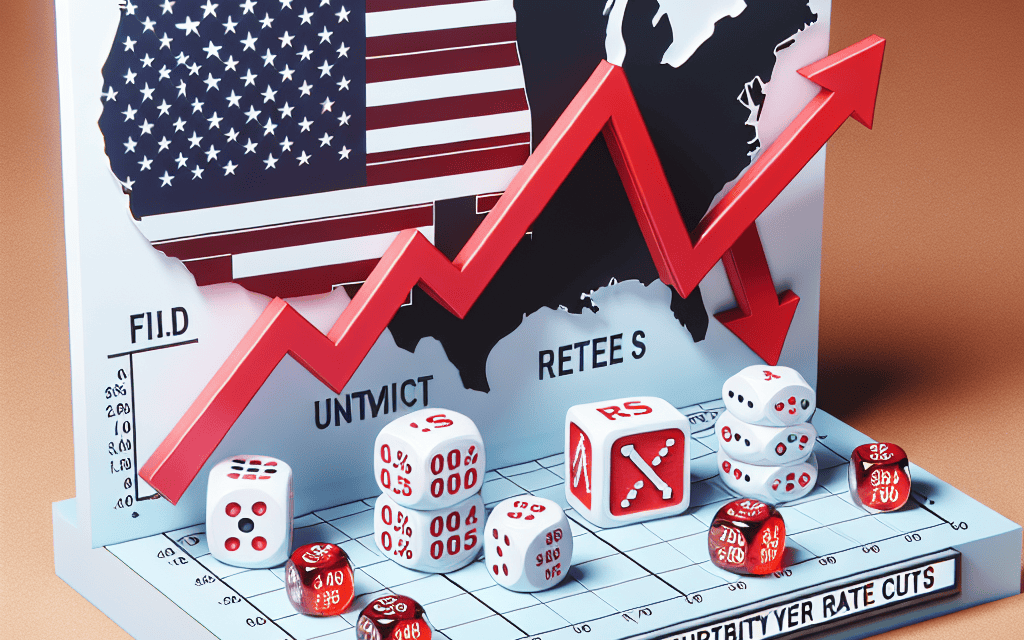“US Stock Futures Dip as Rate Cut Uncertainty Looms: Navigating Market Volatility”
Introduction
U.S. stock futures experienced a decline as investors grappled with uncertainty surrounding potential interest rate cuts by the Federal Reserve. This market movement reflects growing apprehension about the central bank’s monetary policy direction amid mixed economic signals. Investors are closely monitoring economic data releases and Fed officials’ statements for clues on future rate adjustments, which could significantly impact market dynamics. The decline in futures suggests a cautious sentiment among traders, who are weighing the implications of rate cuts on economic growth and inflation. As the market navigates this period of uncertainty, volatility is expected to persist, with investors remaining vigilant to any developments that could influence the Fed’s policy decisions.
Impact Of Interest Rate Speculation On US Stock Futures
The recent decline in US stock futures has been largely attributed to the prevailing uncertainty surrounding potential interest rate cuts by the Federal Reserve. This speculation has created a ripple effect across financial markets, influencing investor sentiment and leading to heightened volatility. As market participants grapple with the implications of possible monetary policy adjustments, the impact on stock futures has become increasingly pronounced.
To understand the current situation, it is essential to consider the broader economic context. The Federal Reserve, tasked with maintaining economic stability, often adjusts interest rates in response to changing economic conditions. Lowering interest rates typically aims to stimulate economic growth by making borrowing cheaper, thereby encouraging spending and investment. Conversely, raising rates is intended to curb inflation and prevent the economy from overheating. However, the decision to alter interest rates is complex and influenced by a myriad of factors, including employment data, inflation trends, and global economic developments.
In recent months, mixed economic signals have fueled speculation about the Federal Reserve’s next move. On one hand, certain economic indicators suggest a slowdown in growth, prompting calls for rate cuts to avert a potential recession. On the other hand, inflationary pressures remain a concern, leading some analysts to argue against premature easing of monetary policy. This dichotomy has left investors in a state of uncertainty, as they attempt to anticipate the central bank’s actions and adjust their strategies accordingly.
The impact of this uncertainty is evident in the performance of US stock futures. Futures contracts, which allow investors to speculate on the future direction of stock indices, are particularly sensitive to changes in interest rate expectations. When investors believe that rate cuts are imminent, they often become more optimistic about the prospects for corporate earnings and economic growth, leading to an increase in stock futures. Conversely, when doubts arise about the likelihood of rate cuts, as is currently the case, stock futures tend to decline as investors reassess their risk exposure.
Moreover, the uncertainty surrounding interest rate policy has also contributed to increased market volatility. As investors react to new economic data and statements from Federal Reserve officials, stock futures experience sharp fluctuations. This volatility can be both a challenge and an opportunity for market participants. While it creates risks for those with existing positions, it also presents potential gains for those adept at navigating short-term market movements.
In addition to domestic factors, global economic developments further complicate the outlook for US stock futures. Trade tensions, geopolitical uncertainties, and economic slowdowns in key regions all play a role in shaping investor sentiment. As these external factors interact with domestic monetary policy considerations, the resulting complexity adds another layer of uncertainty to the market.
In conclusion, the decline in US stock futures amid uncertainty over potential interest rate cuts underscores the intricate relationship between monetary policy and financial markets. As investors continue to weigh the implications of possible Federal Reserve actions, the impact on stock futures is likely to persist. Navigating this environment requires a keen understanding of both economic fundamentals and market dynamics, as well as the ability to adapt to rapidly changing conditions. As the situation evolves, market participants will remain vigilant, seeking to capitalize on opportunities while managing the inherent risks associated with interest rate speculation.
Analyzing Market Volatility Amid Rate Cut Uncertainty
US stock futures have recently experienced a decline, reflecting the broader market’s uncertainty regarding potential rate cuts by the Federal Reserve. This volatility underscores the complex interplay between economic indicators, investor sentiment, and monetary policy decisions. As market participants grapple with these uncertainties, the fluctuating stock futures serve as a barometer for the prevailing economic sentiment.
The anticipation of rate cuts often stimulates investor optimism, as lower interest rates can reduce borrowing costs for businesses and consumers, potentially spurring economic growth. However, the current scenario is marked by ambiguity, with mixed signals from economic data and Federal Reserve communications. This has led to a cautious approach among investors, who are keenly observing any developments that might provide clarity on the central bank’s future actions.
In recent months, economic indicators have painted a mixed picture of the US economy. While some data points, such as employment figures and consumer spending, have shown resilience, others, like manufacturing output and inflation rates, have raised concerns. This dichotomy complicates the Federal Reserve’s decision-making process, as it must balance the need to support economic growth with the imperative to keep inflation in check. Consequently, the lack of a clear trajectory for rate cuts has contributed to the prevailing market volatility.
Moreover, the Federal Reserve’s communication strategy plays a crucial role in shaping market expectations. In recent statements, Fed officials have emphasized a data-dependent approach, suggesting that future rate decisions will be contingent on evolving economic conditions. This stance, while prudent, has left investors in a state of uncertainty, as they attempt to interpret the potential implications of each new economic report. The resulting speculation has led to fluctuations in stock futures, as market participants adjust their positions in response to perceived shifts in monetary policy.
Adding to the complexity is the global economic landscape, which exerts additional pressure on US markets. Geopolitical tensions, trade disputes, and economic slowdowns in other regions can influence investor sentiment and, by extension, stock futures. For instance, concerns about a global economic slowdown can lead to increased market volatility, as investors reassess the potential impact on US companies with international exposure. This interconnectedness underscores the importance of a comprehensive approach to analyzing market trends, taking into account both domestic and international factors.
In this environment of uncertainty, investors are increasingly turning to safe-haven assets, such as government bonds and gold, as a hedge against potential market downturns. This shift in investment strategy reflects a broader trend of risk aversion, as market participants seek to protect their portfolios from the unpredictable swings in stock futures. However, this cautious approach can also exacerbate market volatility, as the movement of capital away from equities can lead to further declines in stock prices.
In conclusion, the decline in US stock futures amid uncertainty over rate cuts highlights the intricate dynamics at play in the financial markets. As investors navigate this challenging landscape, they must remain vigilant, continuously assessing the implications of economic data and Federal Reserve communications. By maintaining a nuanced understanding of these factors, market participants can better position themselves to respond to the evolving economic environment, even as uncertainty remains a defining characteristic of the current market climate.
Investor Sentiment And Its Influence On Stock Futures
Investor sentiment plays a crucial role in shaping the trajectory of stock futures, particularly in times of economic uncertainty. As US stock futures experience a decline amid ambiguity surrounding potential rate cuts, understanding the underlying factors influencing investor behavior becomes essential. The current market environment is characterized by a complex interplay of economic indicators, central bank policies, and global events, all of which contribute to the prevailing sentiment among investors.
To begin with, the anticipation of interest rate adjustments by the Federal Reserve is a significant driver of investor sentiment. Rate cuts are generally perceived as a stimulus for economic growth, as they lower borrowing costs for businesses and consumers, thereby encouraging spending and investment. However, the decision to implement such cuts is contingent upon a myriad of economic indicators, including inflation rates, employment figures, and GDP growth. In recent months, mixed signals from these indicators have led to uncertainty regarding the Federal Reserve’s next move, causing investors to adopt a cautious stance.
Moreover, the global economic landscape adds another layer of complexity to investor sentiment. Trade tensions, geopolitical conflicts, and economic slowdowns in key regions can all influence market perceptions and expectations. For instance, ongoing trade negotiations between major economies have introduced a degree of unpredictability, as investors weigh the potential outcomes and their implications for global trade and economic stability. This uncertainty often results in heightened market volatility, as investors react to new developments and adjust their positions accordingly.
In addition to these external factors, corporate earnings reports and forecasts also play a pivotal role in shaping investor sentiment. Companies’ financial performance provides valuable insights into the health of various sectors and the broader economy. Positive earnings surprises can boost investor confidence, leading to increased demand for stocks and a subsequent rise in stock futures. Conversely, disappointing earnings or cautious outlooks can dampen sentiment, prompting investors to reassess their strategies and potentially reduce their exposure to equities.
Furthermore, the psychological aspect of investing cannot be overlooked. Market participants are influenced not only by objective data but also by their perceptions and emotions. Fear and greed, two powerful emotions, can drive market behavior in unpredictable ways. During periods of uncertainty, fear often takes precedence, leading to risk aversion and a preference for safer assets such as bonds or gold. This shift in sentiment can exert downward pressure on stock futures, as investors seek to protect their portfolios from potential losses.
In light of these considerations, it becomes evident that investor sentiment is a multifaceted phenomenon, shaped by a confluence of economic, geopolitical, and psychological factors. As US stock futures decline amid uncertainty over rate cuts, market participants must navigate this complex landscape with caution and diligence. By staying informed about the latest developments and maintaining a balanced perspective, investors can better position themselves to respond to changing market conditions.
In conclusion, the influence of investor sentiment on stock futures is both profound and dynamic. As the market grapples with uncertainty over potential rate cuts, understanding the factors that drive sentiment is crucial for making informed investment decisions. By recognizing the interplay between economic indicators, global events, corporate performance, and psychological factors, investors can gain valuable insights into the forces shaping the market and adjust their strategies accordingly.
Historical Trends: Rate Cuts And Stock Market Reactions

The relationship between interest rate cuts and stock market reactions has long been a subject of interest for investors and economists alike. Historically, rate cuts by the Federal Reserve have often been perceived as a catalyst for stock market rallies. This perception is rooted in the idea that lower interest rates reduce borrowing costs for companies, potentially leading to increased investment and expansion. Additionally, consumers may benefit from lower rates through cheaper loans, which can boost spending and, in turn, corporate profits. However, the current decline in US stock futures amid uncertainty over potential rate cuts suggests a more complex interplay of factors influencing market sentiment.
To understand this dynamic, it is essential to examine historical trends. In past economic cycles, the Federal Reserve has typically cut interest rates in response to signs of economic slowdown or recession. For instance, during the early 2000s and the financial crisis of 2008, rate cuts were implemented to stimulate economic activity. In these instances, the stock market often responded positively, as investors anticipated that lower rates would help stabilize the economy and support corporate earnings.
Nevertheless, the context in which rate cuts occur can significantly influence market reactions. For example, if rate cuts are perceived as a response to severe economic distress, investor confidence may wane, leading to market volatility. This was evident during the 2008 financial crisis when initial rate cuts were met with skepticism, as the depth of the economic downturn became apparent. Conversely, in a more stable economic environment, rate cuts might be viewed as a proactive measure to sustain growth, thereby bolstering investor confidence.
In the current scenario, the uncertainty surrounding potential rate cuts is compounded by several factors. Firstly, the US economy has shown resilience in certain sectors, leading to mixed signals about the necessity and timing of rate adjustments. Secondly, global economic conditions, including geopolitical tensions and trade disputes, add layers of complexity to the decision-making process. These factors contribute to a cautious approach by the Federal Reserve, which in turn fuels uncertainty in the stock market.
Moreover, the market’s reaction to potential rate cuts is also influenced by expectations. Investors often try to anticipate the Federal Reserve’s moves, and any deviation from these expectations can lead to significant market fluctuations. For instance, if the market has already priced in a rate cut and the Federal Reserve decides to hold rates steady, it could result in a negative reaction from investors who were banking on the anticipated stimulus.
In addition to these considerations, the current economic landscape is marked by unique challenges, such as the lingering effects of the COVID-19 pandemic and evolving technological disruptions. These factors further complicate the traditional relationship between rate cuts and stock market performance. As a result, investors are increasingly looking beyond interest rates, considering a broader range of economic indicators and policy measures to gauge market direction.
In conclusion, while historical trends provide valuable insights into the relationship between rate cuts and stock market reactions, the current decline in US stock futures amid uncertainty over rate cuts underscores the complexity of this relationship. As investors navigate this uncertain environment, they must weigh a multitude of factors, including economic indicators, global conditions, and Federal Reserve communications, to make informed decisions. This multifaceted approach is essential for understanding the nuanced interplay between monetary policy and market dynamics in today’s ever-evolving economic landscape.
Strategies For Navigating Stock Futures During Economic Uncertainty
In the ever-evolving landscape of financial markets, investors are constantly seeking strategies to navigate the complexities of stock futures, particularly during periods of economic uncertainty. The recent decline in US stock futures, driven by ambiguity surrounding potential rate cuts, underscores the need for a well-considered approach. As market participants grapple with the implications of monetary policy decisions, it becomes imperative to adopt strategies that can mitigate risks while capitalizing on potential opportunities.
To begin with, understanding the underlying factors contributing to the current market sentiment is crucial. The Federal Reserve’s stance on interest rates plays a pivotal role in shaping investor expectations. When there is uncertainty about rate cuts, it can lead to heightened volatility in stock futures. Investors must stay informed about economic indicators, such as inflation rates and employment data, which influence the Fed’s decisions. By keeping abreast of these developments, investors can better anticipate market movements and adjust their strategies accordingly.
Moreover, diversification remains a cornerstone strategy for managing risk during uncertain times. By spreading investments across various asset classes, sectors, and geographies, investors can reduce their exposure to any single market event. This approach not only helps in cushioning the impact of adverse market movements but also provides opportunities for growth in different areas. For instance, while certain sectors may be adversely affected by interest rate fluctuations, others, such as technology or healthcare, might exhibit resilience or even benefit from such changes.
In addition to diversification, maintaining a long-term perspective is essential. Economic uncertainties, including those related to interest rates, are often short-lived. By focusing on long-term investment goals, investors can avoid making impulsive decisions based on short-term market fluctuations. This approach allows for a more measured response to market volatility, reducing the likelihood of panic selling and enabling investors to ride out temporary downturns.
Furthermore, employing hedging strategies can offer an additional layer of protection. Options and futures contracts can be used to hedge against potential losses in stock portfolios. By strategically using these financial instruments, investors can offset potential declines in their holdings, thereby preserving capital. However, it is important to note that hedging requires a thorough understanding of the instruments involved and should be executed with caution.
Another strategy involves closely monitoring market sentiment and investor behavior. Sentiment analysis tools can provide insights into the collective mood of the market, helping investors gauge whether fear or optimism is driving current trends. By understanding these dynamics, investors can make more informed decisions about when to enter or exit positions.
Finally, maintaining liquidity is a prudent strategy during times of uncertainty. Having readily available cash reserves allows investors to take advantage of buying opportunities that may arise during market downturns. This flexibility can be particularly advantageous when stock prices are depressed, enabling investors to acquire quality assets at a discount.
In conclusion, navigating stock futures during economic uncertainty requires a multifaceted approach. By staying informed, diversifying portfolios, maintaining a long-term perspective, employing hedging strategies, monitoring market sentiment, and ensuring liquidity, investors can better position themselves to weather the challenges posed by uncertain economic conditions. As the market continues to react to potential rate cuts and other economic indicators, these strategies can serve as a valuable guide for investors seeking to manage risk and capitalize on opportunities in the ever-changing financial landscape.
The Role Of Federal Reserve Announcements In Market Movements
The role of Federal Reserve announcements in market movements is a critical aspect of understanding the dynamics of the financial markets, particularly in times of economic uncertainty. Recently, US stock futures have experienced a decline, largely attributed to the ambiguity surrounding potential rate cuts by the Federal Reserve. This situation underscores the profound influence that the Federal Reserve’s communications and policy decisions have on investor sentiment and market behavior.
To begin with, the Federal Reserve, as the central bank of the United States, plays a pivotal role in shaping monetary policy, which in turn affects economic conditions and financial markets. One of the primary tools at its disposal is the manipulation of interest rates. By adjusting the federal funds rate, the Federal Reserve can either stimulate economic activity or cool down an overheating economy. Consequently, any announcements or hints regarding changes in interest rates are closely scrutinized by investors, as they can have far-reaching implications for asset prices and investment strategies.
In the current scenario, the uncertainty over potential rate cuts has created a sense of apprehension among market participants. Investors are keenly awaiting signals from the Federal Reserve regarding its future policy direction. This anticipation is not unfounded, as the central bank’s decisions can significantly impact borrowing costs, consumer spending, and business investment. For instance, a rate cut could lower borrowing costs, thereby encouraging spending and investment, which would be beneficial for economic growth. Conversely, maintaining or increasing rates could signal a more cautious approach, potentially dampening economic activity.
Moreover, the Federal Reserve’s announcements serve as a barometer for the overall health of the economy. When the central bank indicates a willingness to cut rates, it may suggest concerns about economic slowdown or other underlying issues. This perception can lead to increased volatility in the stock market, as investors reassess their portfolios in light of the new information. The recent decline in US stock futures is a testament to this phenomenon, as market participants grapple with the implications of potential rate cuts and their impact on future economic conditions.
Furthermore, the Federal Reserve’s communication strategy plays a crucial role in managing market expectations. Through carefully crafted statements and press conferences, the central bank aims to provide clarity and guidance to investors. However, the inherent complexity of economic conditions and the multitude of factors influencing policy decisions can sometimes lead to mixed signals. This ambiguity can exacerbate market volatility, as investors attempt to decipher the central bank’s intentions and adjust their strategies accordingly.
In addition to the direct impact on interest rates, Federal Reserve announcements can also influence market movements through their effect on currency values and inflation expectations. A rate cut, for example, could lead to a depreciation of the US dollar, affecting international trade and investment flows. Similarly, changes in inflation expectations can alter the perceived attractiveness of different asset classes, prompting shifts in investment allocations.
In conclusion, the role of Federal Reserve announcements in market movements is both significant and multifaceted. As evidenced by the recent decline in US stock futures, the central bank’s communications and policy decisions are closely monitored by investors, who seek to navigate the complexities of the financial markets. By understanding the interplay between Federal Reserve actions and market dynamics, investors can better position themselves to respond to the challenges and opportunities that arise in an ever-evolving economic landscape.
Comparing US Stock Futures With Global Market Trends Amid Rate Speculation
US stock futures have recently experienced a decline, reflecting the broader uncertainty surrounding potential rate cuts by the Federal Reserve. This development has captured the attention of investors who are keenly observing the central bank’s next moves. The anticipation of rate adjustments has historically influenced market behavior, and the current situation is no exception. As investors grapple with the implications of potential rate cuts, it is essential to compare these trends with global market movements to gain a comprehensive understanding of the financial landscape.
In the United States, the Federal Reserve’s monetary policy decisions are pivotal in shaping market expectations. The possibility of rate cuts often signals an attempt to stimulate economic growth, especially when faced with signs of a slowdown. However, the current economic indicators present a mixed picture, leaving investors in a state of uncertainty. While some sectors show resilience, others exhibit signs of strain, complicating the Federal Reserve’s decision-making process. This ambiguity has led to fluctuations in US stock futures, as market participants attempt to predict the central bank’s course of action.
Transitioning to the global stage, it is evident that the US is not alone in facing monetary policy challenges. Across the Atlantic, the European Central Bank (ECB) is also navigating a complex economic environment. Similar to the US, Europe is experiencing a blend of economic signals, with some regions showing robust growth while others lag behind. The ECB’s approach to interest rates and monetary policy is closely watched by investors worldwide, as it can have significant implications for global financial markets. The interconnectedness of economies means that decisions made by major central banks often ripple across borders, influencing investor sentiment and market dynamics.
In Asia, the situation is equally nuanced. The People’s Bank of China (PBOC) has been proactive in its monetary policy, implementing measures to support economic stability amid external pressures. China’s economic performance is a critical factor in global market trends, given its role as a major driver of global growth. As such, any shifts in China’s monetary policy are scrutinized by investors seeking to understand potential impacts on global trade and investment flows. The PBOC’s actions, in conjunction with those of other central banks, contribute to the overall tapestry of global market trends.
Comparing US stock futures with these global market trends reveals a landscape characterized by both divergence and convergence. While each region faces unique challenges, the overarching theme is one of uncertainty regarding monetary policy directions. This uncertainty is compounded by geopolitical factors, trade tensions, and evolving economic conditions, all of which add layers of complexity to the investment environment. Investors are thus tasked with navigating a multifaceted landscape, where local developments are inextricably linked to global trends.
In conclusion, the decline in US stock futures amid uncertainty over rate cuts underscores the intricate interplay between domestic and global market forces. As investors assess the potential implications of central bank decisions, they must also consider the broader context of global economic trends. The interconnected nature of today’s financial markets means that developments in one region can have far-reaching effects, influencing investor sentiment and market behavior worldwide. As such, a comprehensive understanding of both US and global market trends is essential for making informed investment decisions in this dynamic environment.
Q&A
1. **What are US stock futures?**
– US stock futures are financial contracts that speculate on the future value of stock market indices, such as the S&P 500, Dow Jones Industrial Average, and Nasdaq Composite.
2. **Why are US stock futures declining?**
– US stock futures are declining due to uncertainty over potential interest rate cuts by the Federal Reserve, which affects investor sentiment and market stability.
3. **What causes uncertainty over rate cuts?**
– Uncertainty over rate cuts can be caused by mixed economic data, differing opinions among Federal Reserve officials, or geopolitical events that impact economic forecasts.
4. **How do interest rate cuts affect the stock market?**
– Interest rate cuts generally lower borrowing costs, which can stimulate economic activity and boost stock prices. However, uncertainty about cuts can lead to market volatility.
5. **What is the Federal Reserve’s role in rate cuts?**
– The Federal Reserve sets the federal funds rate, influencing interest rates across the economy. It adjusts rates to manage inflation and support economic growth.
6. **How do investors react to uncertainty in rate cuts?**
– Investors may become cautious, leading to increased market volatility, reduced risk-taking, and potential declines in stock prices as they reassess their portfolios.
7. **What other factors can influence US stock futures?**
– Other factors include corporate earnings reports, global economic conditions, geopolitical tensions, and changes in fiscal policy.
Conclusion
US stock futures have experienced a decline due to prevailing uncertainty regarding potential rate cuts by the Federal Reserve. This uncertainty has created a cautious atmosphere among investors, who are closely monitoring economic indicators and central bank communications for clearer guidance on future monetary policy. The lack of consensus on the timing and magnitude of rate adjustments has contributed to market volatility, as participants weigh the implications for economic growth and corporate earnings. As a result, the market remains in a state of flux, with investors seeking clarity on the Fed’s approach to balancing inflationary pressures with the need to support economic activity.





